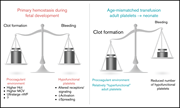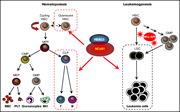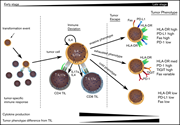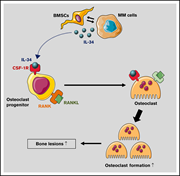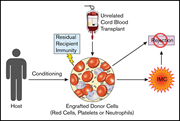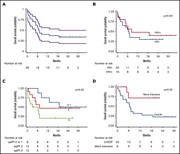Issue Archive
Table of Contents
BLOOD ADVANCES TALK
Daily light-and-darkness onset regulates mouse hematopoietic stem cells
In this issue’s Blood Advances Talk, Lapidot and Golan discuss how changes in daily light regulate hematopoiesis. This fascinating mechanism helps control the process of maintaining the hematopoietic stem cell pool while promoting sufficient differentiation to supply adequate numbers of functional blood cells. We hope you enjoy listening to this interesting topic.
STIMULUS REPORTS
Central nervous system–restricted familial hemophagocytic lymphohistiocytosis responds to hematopoietic cell transplantation
Clinical Trials & Observations
REVIEW ARTICLE
Ontogeny of platelet function
Sperandio and colleagues review the ontogeny of platelet function during development, highlighting a number of important biological insights and how these novel findings impact platelet transfusion therapy in neonates.
CLINICAL TRIALS AND OBSERVATIONS
Pracinostat plus azacitidine in older patients with newly diagnosed acute myeloid leukemia: results of a phase 2 study
Clinical Trials & Observations
The treatment of older patients with acute myeloid leukemia (AML) presents critical challenges due to toxicities and comorbid medical conditions. Garcia-Manero and colleagues explore the combination of pracinostat, a potent pan-histone deacetylase inhibitor, and azacytidine in older patients with newly diagnosed AML who were ineligible for standard intensive induction regimens. Their findings support this combination as one that is well tolerated with favorable complete remission and one-year survival rates justifying further evaluation of this approach.
Phase 2 study of clarithromycin, pomalidomide, and dexamethasone in relapsed or refractory multiple myeloma
Clinical Trials & Observations
HEMATOPOIESIS AND STEM CELLS
HMGA2 promotes long-term engraftment and myeloerythroid differentiation of human hematopoietic stem and progenitor cells
Larsson et al tackle the critical issue of fate choice in hematopoietic stem cells. They demonstrate that HMGA2 is highly expressed on the most immature progenitor cell subsets of fetal, neonatal, and adult human hematopoiesis. They also demonstrate that modulation of this gene's expression significantly affects hematopoietic reconstitution after transplant.
IMMUNOBIOLOGY AND IMMUNOTHERAPY
Progression of mycosis fungoides occurs through divergence of tumor immunophenotype by differential expression of HLA-DR
Clinical Trials & Observations
Immunotherapy has emerged as a major treatment option for a number of malignancies. Mycosis fungoides (MF) is particularly interesting since it is a disorder of malignant CD4+ T cells and infiltrates the skin that allows for ready access and characterization. Murray and colleagues evaluate and contraste MF cells with tumor infiltrating lymphocytes to highlight important differences that may have clinical implications for future immune-based therapies.
PD-L1 and tumor-associated macrophages in de novo DLBCL
Clinical Trials & Observations
Checkpoint inhibitors have had a major impact on the treatment of a number of malignancies. However, responses in patients with diffuse large B-cell lymphoma have been disappointing. Venstrom and colleagues explore the role of programmed death-ligand 1 expression in the tumor microenvironment that may help explain these clinical observations.
Potentiation of complement regulator factor H protects human endothelial cells from complement attack in aHUS sera
Mutations in the complement cascade can cause a number of deadly diseases, including atypical hemolytic uremic syndrome (aHUS). While we can successfully treat aHUS by inhibiting the terminal complement pathway, such treatment can negatively impact a patient's ability to fight pathogens. Pouw et al identify a novel antibody that effectively separates the endothelial damage wrought by complement from the protection against pathogens.
LYMPHOID NEOPLASIA
A role for IL-34 in osteolytic disease of multiple myeloma
Osteolytic bone disease is one of the most disabling complications of multiple myeloma that leads to significant morbidity and occasionally mortality. In the report by Seino and colleagues, the role of interleukin-34, a ligand of colony stimulating factor 1, in osteolytic bone disease in multiple myeloma is evaluated with provocative findings that potentially identifies a novel clinical target for controlling this common complication of this disease.
Frequent germline mutations of HAVCR2 in sporadic subcutaneous panniculitis-like T-cell lymphoma
MYELOID NEOPLASIA
Complex karyotype AML displays G2/M signature and hypersensitivity to PLK1 inhibition
PLATELETS AND THROMBOPOIESIS
THROMBOSIS AND HEMOSTASIS
Inhibition of contact-mediated activation of factor XI protects baboons against S aureus–induced organ damage and death
TRANSPLANTATION
The impact of the graft-versus-leukemia effect on survival in acute lymphoblastic leukemia
Yeshurun et al describe a study of a large number of acute lymphoblastic leukemia (ALL) patients using the CIBMTR registry and seek to understand 2 central questions of hematopoietic transplant for leukemia. One, is there a graft-versus-leukemia (GVL) effect that is tied to graft-versus-host disease (GVHD) for ALL? Two, if so, how does one “thread the needle” to get the best impact of GVL without undue toxicity, morbidity, and mortality from GVHD? This article provides compelling data that children and adults in first or second complete remission did best when they developed grade I or II acute GVHD (aGVHD) without chronic GVHD (cGVHD) compared to no GVHD. However, the same patients demonstrated increased nonrelapse mortality accompanying grade III or IV aGVHD, which abrogated any protection from relapse. This article reiterates the difficult balance doctors face optimizing outcomes for patients undergoing transplant for leukemia and demonstrates that severe aGVHD changes the balance against survival.
GLOBAL ADVANCES
Prospective study of Burkitt lymphoma treatment in adolescents and adults in Malawi
Clinical Trials & Observations
Global Advances
COMMENTARIES
What the 2018 ASH venous thromboembolism guidelines omitted: nonadministration of pharmacologic prophylaxis in hospitalized patients
-
Cover Image
Cover Image
![issue cover]()
COVER FIGURE
The image demonstrates Ki67 expression of a Burkitt lymphoma patient from Malawi. See the article by Painschab et al. - PDF Icon Front MatterFront Matter
- PDF Icon Editorial BoardEditorial Board
Advertisement intended for health care professionals
Advertisement intended for health care professionals


